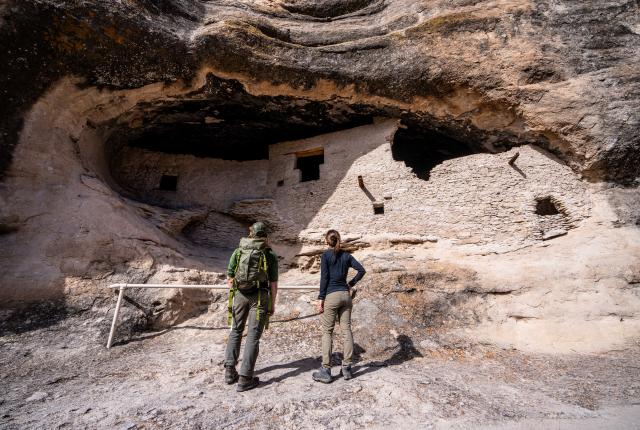“THIS WHOLE MOUNTAIN VALLEY wasn’t some wilderness nobody visited,” says Dana Dick, Gila Cliff Dwellings National Monument’s lead interpretive park ranger. “It was home to people. There’s evidence of people living here for at least 2,000 years.”
A transition zone where desert plants and animals meet those of the foothills and mountains, the Gila River’s biodiverse landscape only increases its appeal to humans. “The natural resources and water have attracted people here forever,” Dick says.
With a seasonal creek feeding into the West Fork of the Gila River, Cliff Dweller Canyon hosts 500 plant species—more than 30 of which the architects of the cliff dwellings ate and used as medicine. “These people are all expert farmers, but they would supplement with their wild foods: canyon grapes, piñon nuts, juniper berries,” Dick says. “There are tons of sunflowers. Wherever sunflower grows is where there’s good farmland.”
During a great drought in the late 1200s, clans of 40 to 60 Tularosa Mogollon people occupied and improved—building walls and roofs—the three natural caves above Cliff Dweller Creek. “The ponderosa pine that grow here are straight, tall, big,” Dick says, pointing out that the inhabitants constructed roofs even over the structures inside the caves. “It keeps in heat for starters, and they used their roofs as a whole other living space.”
But after residing in these caves and farming on the nearby mesas for only two or three decades, the Tularosa Mogollon moved on. “That’s the easy version of the story, but I’m sure it was way more complex,” Dick says. “You see these sites all over the Southwest, and they do indicate this way of life of moving around and letting these resources replenish themselves.”
Archaeological excavations of other nearby ruins haven’t revealed why multiple groups would have lived so close to one another with a scarcity of resources. There’s also the question of the Apache people. “When did the Chiricahua Apache come here? Archaeologists will say 1400, but if you ask [the Chiricahua Apache], they’ll say they’ve always been here,” says Dick, who refers to any early inhabitants of the Gila forks area as simply The People. “All these names we hear, like Tularosa Mogollon, were given to them by archaeologists, who are more often than not Anglo American.”
Clarity may never come. While the excavations carried on in the 1950s, ’60s, and ’70s did uncover important artifacts like atlatl fragments, stone tools, and corncobs, archaeologists “didn’t do a super good job,” Dick says, because they were too focused on collecting artifacts for museums rather than for study. Even the first records of visits to the cliff dwellings, by prospectors like Henry B. Ailman, don’t accurately point to the timeline of their discovery.



